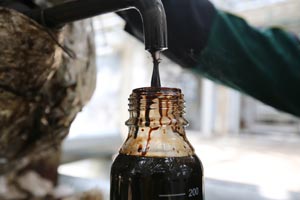Crude Losses Ease as Dollar Drop Offsets US Drilling Boom

Oil eased losses as growth in U.S. drilling was partially offset by a weaker dollar.
Futures were little changed after earlier falling as much as 1%. U.S. explorers added 11 rigs last week to cap the longest stretch of gains since 2011, according to data from Baker Hughes Inc.
Bloomberg’s Dollar Spot Index fell to the weakest in three weeks as soft inflation data from the U.S. cast doubt on the pace of Federal Reserve rate hikes. A weak American currency bolsters the appeal of commodities priced in the dollar. Saudi Arabia’s Energy Minister Khalid Al-Falih said April 17 that the oil market is on the road to re-balancing.
The expansion in U.S. drilling is damping optimism that had lifted prices above $53 a barrel after some members of the Organization of Petroleum Exporting Countries expressed support for prolonging production cuts with other nations beyond June. While U.S. crude stockpiles declined from a record, OPEC said April 12 in a report that rivals in the American shale industry are growing stronger.
"There’s nothing energy specific that explains this move" from the session lows, Bob Yawger, director of the futures division at Mizuho Securities USA Inc. in New York, said by telephone. "Risk assets tuned from negative to positive and oil followed. There are still a lot of negative factors weighing on energy."
West Texas Intermediate for May delivery fell 1 cent to $53.17 a barrel at 9:04 a.m. on the New York Mercantile Exchange. Futures gained 1.8% last week to close at $53.18 a barrel. Total volume traded was about 45% below the 100-day average.
Brent for June settlement rose 2 cents, to $55.91 a barrel on the London-based ICE Futures Europe exchange. The global benchmark crude traded at a $2.35 premium to June WTI. No futures were traded in New York or London on April 14 due to the Good Friday holiday.
OPEC members and other oil producers are showing “very good” compliance with the promised output cuts they began making in January, Al-Falih told reporters at a conference in Riyadh. Oil inventories are rising partly because of refinery maintenance, he said.
The U.S. drill rig count climbed to 683 last week, the highest since April 2015 and a 13th week of gains, Baker Hughes data showed on April 14.
The number of working rigs has more than doubled from a 2016 low of 316 in May. Explorers in Texas led the week’s growth, with eight more rigs put to work in the Permian Basin in the western part of the state and in neighboring New Mexico, while three started up in the Eagle Ford of south Texas.
Oil-market news:
• China’s economy accelerated for a second-straight quarter, according to data from the National Bureau of Statistics. Gross domestic product for the world’s second-biggest oil user increased by 6.9% in the first three months.
• Hedge funds boosted bets on higher WTI crude prices a second week as futures topped $53 a barrel for the first time in a month, U.S. Commodity Futures Trading Commission data show.
• Nigeria will revive oil production this summer as it completes maintenance and repairs, and expects fellow OPEC members to continue to cut their output in the second half of the year, Oil Minister Emmanuel Kachikwu said.




